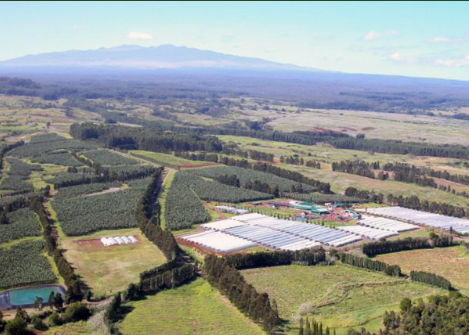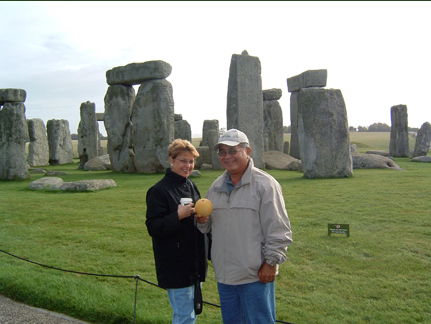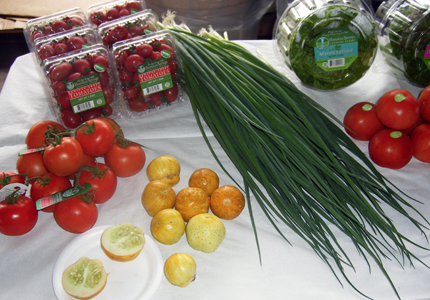Richard Ha wrote:
Our farm is one of 12 founding members of Hawai‘i’s “Seal of Quality” program, which includes some of the state’s most progressive farmers in partnership with seven of its highest profile chefs.
After nine months, we now have 26 farmers in the Seal of Quality program and more are coming on board.
This Department of Agriculture program aims to brand high quality, locally grown products in such a way that farming in Hawai‘i is a sustainable occupation.

Founding farmers, at a luncheon with Governor Lingle to kick off the Seal of Quality program
That’s a pretty heavy concept. And it’s one that all the farmers involved are taking pretty seriously.
I attended a meeting recently of the 12 founding members, all farmers. I looked around the conference room at the Department of Agriculture on O‘ahu and it struck me, hard, that this is a group of “do-ers.” Each is successful in his or her own right and I have tremendous respect for each one.
It’s a group of dynamic entrepreneurs and some synergy is starting to happen. None of those people had to be there at that meeting. They were only there because they considered there to be some real benefit to being there.
The Seal of Quality members are feeling like this might be the start of something really important and big.
To give some history on this Seal of Quality program, let me tell you a story.
Many years ago, when “Hawai‘i Regional Cuisine” chefs were just starting out, chefs over in Kohala, like Peter Merriman and Alan Wong, couldn’t get fresh produce locally. They had to import produce from the mainland.
The chefs made it known that they would pay well for fresh produce grown locally. They encouraged local farmers to start growing specifically for them, and to just come to the back door where they would pay them directly. That was pretty revolutionary at the time, and it was the start of Hawai‘i Regional Cuisine.
So what was being grown locally started being diverted to the chefs. Farmers started making more money and so they could afford to grow their businesses. What was happening gave farmers hope that they could produce a good quality product and be sustainable.
At that time I heard that Peter Merriman, who was working at one of the Kohala Coast resorts, said, “I’d like to see one of my farmers drive up in a Mercedes Benz.”
What was happening over there didn’t affect me at the time, as I was growing bananas on the other side of the island in Hilo. Peter probably had no idea who I was. But I was so impressed by his statement and what it represented that I called Peter at home and thanked him on behalf of farmers everywhere. We both remember that day many years ago.
If you fast-forward 15 years, now there’s a market for fresh local produce, and a big movement to support local produce—and it’s driven by those same Hawai‘i Regional Cuisine chefs. Are there farmers driving Mercedes? I don’t know! What I do know is that the Hawai‘i Regional Cuisine chefs have changed the way we eat as well as how consumers perceive locally grown products.

Lani Weigert, co-owner & marketing director, Ali‘i Kula Lavender; Governor Linda Lingle; Lieutenant Governor Duke Aiona; Speaker of the House Calvin Say
And now, 15 years later, seven of those top Hawai‘i Regional Chefs are officially partnering with and supporting this group of Seal of Quality farmers, as they have supported so many farmers since those early days.
Maybe ten years ago, Chef Sam Choy did a free cooking demonstration at the Pearl Harbor Commissary with us. Our grandson was walking around in a banana suit then. (Recently, the military buyer there asked me to have our grandson wear the banana outfit again. I told her that Kapono was 4 feet tall then; he is 6 feet tall now. I don’t think he is into banana costumes any more.)
Roy Yamaguchi did a segment on our banana farm for his cooking show more than 10 years ago, and our picture and a description of what we do appear in his cookbook. He has done similar things for many other farmers.
And Chef Alan Wong recently invited several Seal of Quality members to attend his birthday party, where contestants from Top Chef, the country’s top-rated reality cooking show, prepared the food as the show’s semi-final competition. An estimated two million viewers across America saw the farmers on TV.
The Seal of Quality group was also invited to bring its products to the Top Chef final competition—the program’s finale, aired a week later—which taped in Kona at the Hilton Waikoloa, and where Chef Roy Yamaguchi was a guest judge. I represented the Seal of Quality producers who could not attend at a mock “farmer’s market,” where the contestants sampled and selected ingredients for their final competitions. Other Seal of Quality members set up their own displays.
As the Hawai‘i Regional Cuisine chefs profoundly changed the way we eat, this partnership between the chefs and Seal of Quality farmers has the potential to change the way Hawai‘i farms.

The very high-profile chefs use our products when they make their presentations to their guests. What they are doing is giving us a venue to show off our products, which adds a lot of value to our products.
And the effect of that is it makes farming sustainable.
What do I mean by "sustainable?" People say that the next generation doesn’t want to farm. But I believe the next generation would be more than willing to farm if they saw a vision for the future that was profitable.
A lot of our vision for farming goes beyond the traditional fertilizing of the plant and harvesting the fruit. The next generation is looking for something exciting—and watching plants grow is not exciting. We’ve got to stretch their imaginations; give them hope and things to look forward to. This is what will pull the next generation along, and this, I think, is the biggest benefit of the Seal of Quality program.
When I look around at the founding Seal of Quality members, most run family farms with children who are actively involved in the company. These farmers’ children see their parents’ vision for the future. They have learned that it’s possible to shape that future and also be profitable and successful.

Dean Okimoto of Nalo Farms; Rep. Ryan Yamane, Chairperson of the House Tourism Committee; Speaker of the House Calvin Say; Dr. Cal and Kay Lum, North Shore Cattle Company.
We Seal of Quality members are also trying to make decisions for our mutual benefit. For instance, one of the Seal of Quality members is Jim Reddekopp, who owns the Hawaiian Vanilla Company. In addition to farming he organizes farm tours, and recently he asked if we would host a group of 20 people at Hamakua Springs for an hour. I would normally have declined, just due to the logistics of it, but because he’s a Seal of Quality member, I said sure. I would make similar decisions for other members, too, as the opportunity arises.
Building alliances is another tool that will help agriculture in the future.
What is the Seal of Quality exactly? On one level, it’s a sticker.
Seal of Quality products are, by definition, “Genuine, Hawaii Grown, Hawaii Made, Premium Products.”
I’ve heard that tourists from Japan are told about the Seal of Quality label and they look for it. When they see a product that doesn’t have the label, they think it must be off grade or something. So the message is getting out. I’m realizing we cannot get lazy and forget to label any of our products!
We’ve had labeling programs before that started out standing for quality, but you’re only as strong as your weakest link. In the Seal of Quality program, we don’t have any weak links.
Together, the Seal of Quality farmers can influence consumers to purchase locally grown products instead of imported ones. They can also influence decision makers on important issues concerning Hawai‘i agriculture.

Richard and June Ha of Hamakua Springs Country Farms; Eric Tanouye of Green Point Nurseries; Clifton Tsuji, Chair of the House Agriculture committee
It’s a program our legislators should support as they work to make Hawai‘i agriculture sustainable into the future. A bill in the legislature right now would deposit the proceeds from Seal of Quality labels into a special fund, rather than have them go into the general fund. This will allow the program to use those funds for advertising and marketing activities, and to draw down federal matching funds. They will be monies from members, to members, and for members – A self-sufficiency concept.
Most importantly, it would allow the program to plan long term. Monies would likely be available consistently, in good times as well as tougher ones, which is precisely when targeted marketing is important. In other words, it will allow the Seal of Quality program to operate like a business.
The Seal of Quality stands for quality, and we plan to maintain and defend that quality.
Click here for a list of the founding Seal of Quality farmers and chefs.











